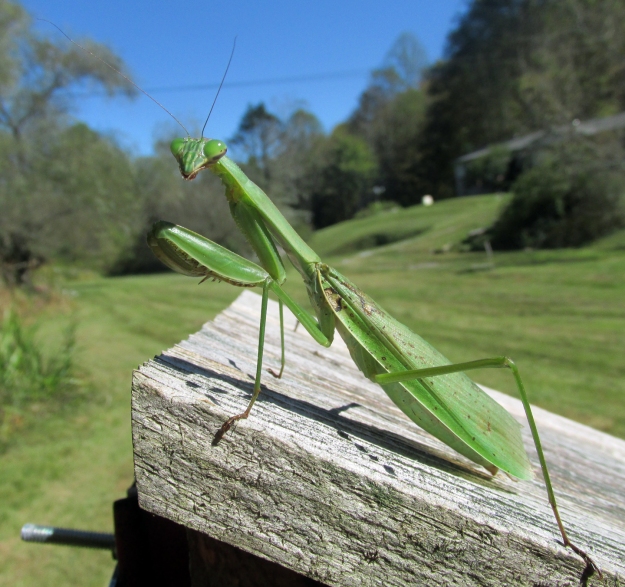
Photo by Bryan Stevens • Large mantises have been known to prey on ruby-throated hummingbirds.
Many years ago I read an account of a scarlet tanager making a snack of a ruby-throated hummingbird. Memory being what it is, I am no longer sure if that account was corroborated or one of those urban legends of birding.
A few pertinent facts should be considered. Male scarlet tanagers look striking in their red and black plumage. Ruby-throated hummingbirds are attracted to the color red. In the details I recall of the story about the predatory tanager, the hummingbird kept flying close to the tanager as if attracted to the red plumage. If so, it was a case of curiosity kills the cat or, in this case, the hummingbird. The tanager seized the hummingbird in its bill and, for good measure and to “tenderize” its prey, beat the hummingbird against the side of a branch. All of this took place before a crowd of birders who observed the incident through their binoculars. I don’t recall anyone taking a photo of the hummingbird’s tragic demise.
An email from Gene Counts reminded me of the tale of the tanager and the hummingbird. Gene, who lives in Haysi, Virginia, sent me a photograph and a short note about a praying mantis that stalks hummingbirds as they visit his feeders for a sip of sugar water.

Photo by Gene Counts • This photo was shared by Gene Counts, who described how the mantis stalked hummingbirds that came to his feeder.
Gene told me of his excitement upon capturing the large insect’s behavior in a photograph.
“I just had to share this picture with you,” Gene wrote. “After all, my wife, Judy, was more excited today than the day we married in Chicago 54 years ago.”
He certainly hooked my attention with that introduction.
“A praying mantis is using our feeder as his own private hunting preserve,” Gene continued in his email. “The mantis follows and stalks the hummingbirds all the way around 360 degrees.”
So far, the stalking has only resulted in “several near misses,” but Gene declared that he is ready to pounce in case the mantis gets lucky.
“It has been four hours and he has lowered his goal,” Gene wrote of the patient mantis. “He is now clinging to the bottom (of the feeder) waiting for an insect. Now I can expel my breath as he no longer an avian threat.”
While Gene’s mantis may not be an immediate threat to hummingbirds visiting his yard in Haysi, does that mean we can be complacent when these large insects share our yards and gardens with hummingbirds?
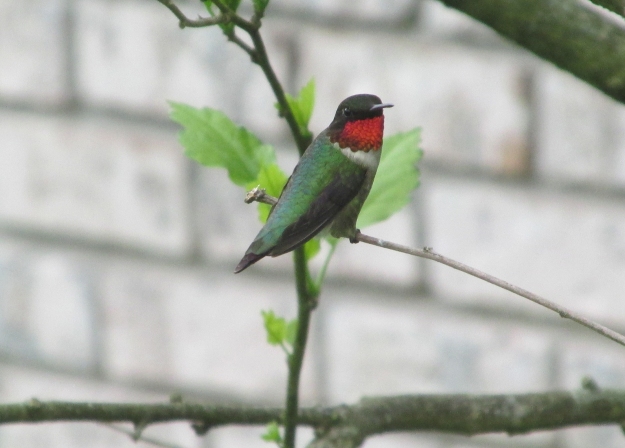
Photo by Bryan Stevens • Numbers of Ruby-throated Hummingbird in the region tend to fluctuate each year, but people should usually see a spike in their numbers as the hummingbirds end summer nesting and start migrating south again.
Documented evidence exists to identify large praying mantises as predators on ruby-throated hummingbirds. A brief foray online found numerous instances of hummers falling victims to these large carnivorous insects.
There are two species of mantises in the region — the European, or praying mantis, and the Chinese mantis — capable of capturing hummingbirds. Both species were introduced in the 1800s to act as a predator of insect pests detrimental to crops and gardens. The Chinese mantis can reach a length of 4.3 inches, while the European mantis achieves a length of about 3.5 inches. A third species — Carolina mantis — reaches only a length of 2.5 inches and should not pose a threat to ruby-throated hummingbirds, which are about 3.5 inches long.
Although introduced from Europe, the European mantis (Mantis religiosa) has earned recognition as the official state insect of Connecticut. The native Carolina mantis is the official state insect for South Carolina.
In Central and South America, where the world’s more than 300 species of hummingbirds reach their greatest diversity, there are also more species of predatory mantises. Some of these tropical insects prey on the tropical counterparts to the ruby-throated hummingbird.
Consider the way the mantis makes a perfect predator. It’s spiky forelimbs are spiky and serrated, making them perfect for seizing and grasping. This insect’s triangular head can turn their heads 180 degrees to scan its surroundings with two large compound eyes. A mantis also has three other simple eyes to increase its keen vision. Brutal mouthparts can easily tear apart and devour any prey the mantis manages to catch with its ambush hunting style.
Hummingbirds, regardless of species, are in a tough spot in the food chain. A bird not much bigger than many large insects is going to be a target for opportunistic predators like a mantis that will attempt to kill and consume anything small enough for them to make the effort.
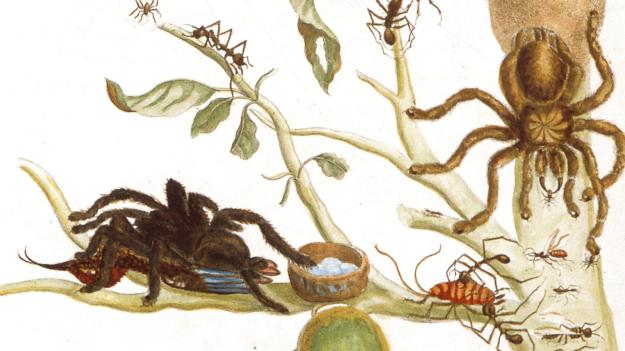
Maria Sibylla Merian, a German-born naturalist and scientific illustrator, was one of the first naturalists to observe insects directly. She painted this horrific work featuring a large spider preying on a hummingbird that had been dutifully incubating her eggs. When she died in 1717, she was recognized as one of the world’s foremost entomologists.
To make matters worse for ruby-throated hummingbirds, some large spiders and the bigger dragonflies have also been documented as hummingbird predators. When ruby-throated hummingbirds retreat to Central America for the winter months, they also face threats from lizards and snakes.
The list of predators that have been known to eat ruby-throated hummingbirds extends to bullfrogs, as well as many raptors, including kestrels, merlins and sharp-shinned hawks. Blue jays and other birds will raid hummingbird nests for eggs or young. Squirrels and chipmunks are also nest predators.
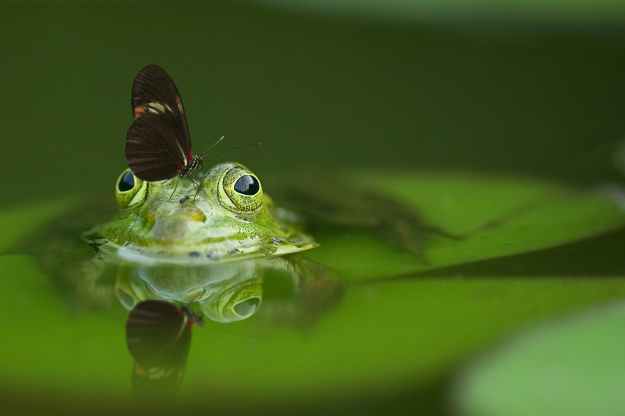
Photo by Pixabay on Pexels.com. Large frogs have also been known to prey on hummingbirds.
Despite all these perils, some ruby-throated hummingbirds have achieved a “long” life. The oldest on record was a ruby-throated hummingbird banded at the age of nine years and one month. Most elder hummingbirds are females. Few male hummingbirds, perhaps because of the energy they expend dueling with each other, reach their fifth birthday.
It’s definitely not easy being as tiny as a hummingbird in a world of fearsome giants, but birders who have seen a hummingbird hover boldly in front of their faces know how these tiny birds take life in stride. They may have a disadvantage in size, but that doesn’t keep them from living life as if they were as big as an eagle.
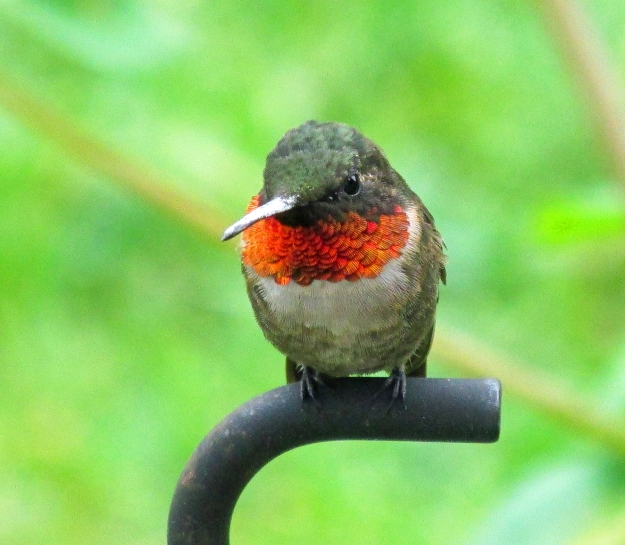
Photo by Bryan Stevens • Despite a perceived disadvantage of size, ruby-throated hummingbirds are quite capable of thriving in a giant world.
